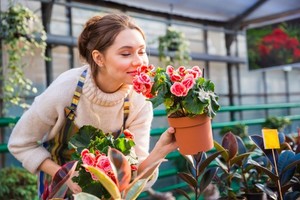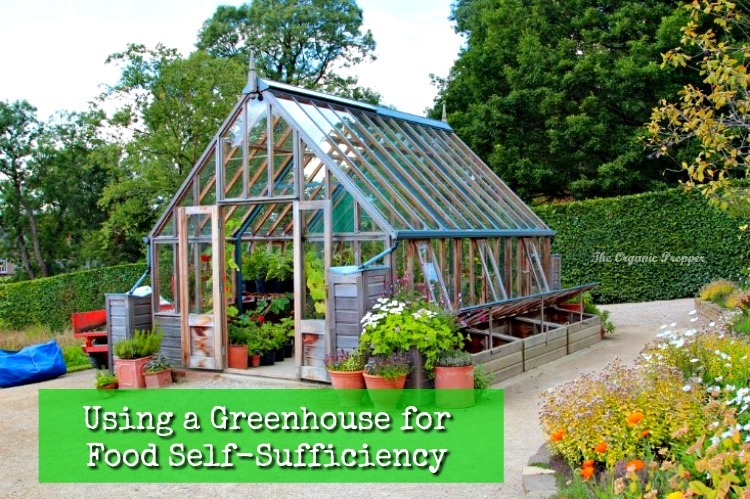If you're new here, you may want to subscribe to my RSS feed. Thanks for visiting!
by Jackie Roberson
This Greenhouse Invention from Purdue Could Help Address the Global Food Crisis
Recently, researchers at Purdue University have been working on creating an automated conveyor-belt type system for their 1,000-square-foot, on-campus greenhouse that’s designed to keep plants within the structure constantly moving. The team hopes that developing this technology will pave the way for options to address the looming global food crisis, as the world’s population is expected to grow to over nine billion by 2050.
The conveyor system will ensure all plants receive consistent growing conditions within a greenhouse; plus the researchers are working to determine the best possible seeds to use to create the highest crop yields, based on the uniform conditions created inside. The team is also hoping to discover which seeds are the most drought- and climate-resistant.
Here’s How You Can Better Utilize a Greenhouse Too
As more and more people focus on how to solve the food crisis, as well as how to limit the environmental damage done by farmers, corporations, and general over-population, individuals can also take steps to grow more of their own food and limit their carbon footprint.
If you want to increase your self-sufficiency, and help the planet at the same time, using a greenhouse can be a great step.
If you’ve never used one before, or haven’t had the results you’ve expected, it’s important to understand some of the best ways to use the structure effectively. Whether you choose a small basic greenhouse or one of the larger hoop greenhouses which are on the market, the basics stay the same. Read on for some tips to follow today.
Choose the Best Greenhouse for Your Needs
For starters, it’s important to purchase the best greenhouse for your specific needs. There are lots of different designs and styles of greenhouses to choose from these days, from traditional to more modern products, and from the smallest of structures up to large ones. There are custom-designed options too.

Also, weigh up things like if you want something with a modular, easily-changeable internal infrastructure (so you can adjust the layout of plants over time); and a free-standing, walk-in design with four sides, or a lean-to option which can be set against a wall or building. There are different types of glazing available too. You can choose standard glass or safety glass, for instance.
Place It in the Right Position
Next, once you get your greenhouse home, you need to find the perfect position for it. All greenhouses need to be erected in a spot where they will get lots of sunlight on each side. As such, avoid positioning your purchase close to large, overhanging structures (like hedges, fences etc.), or large trees. These will likely cast too many shadows.
As well, look for a firm foundation for your greenhouse. You generally don’t want to put it directly over soil; instead look for a solid foundation such as brick, timber, recycled plastic lumber, or concrete. You should think about the likely maintenance of each product choice too, as some will be more likely to retain moisture and rot than others.
Keep Pests at Bay
It’s necessary to keep pests at bay too. While you might think using a greenhouse means pests can’t get into your plants, this, unfortunately, isn’t the case. Enclosed structures like these can actually be a breeding ground for pests like mealybugs, fungus gnats, leafminers, spider mites, aphids, thrips and more.
To reduce the issue, always check that plants, particularly woody ones like gardenias, are free of pests before you bring them into your greenhouse. As well, when you add new plants, keep them separate from the rest of your collection by placing them in a slightly quarantined spot. This way, non-flying pests won’t be able to easily spread around the greenhouse.
Furthermore, introduce biological pest controls to keep the pests which do end up in your structure in check. Ladybugs, for example, are brilliant at fighting aphid infestations.
Clean and Maintain It Regularly
Lastly, make sure you clean and maintain your greenhouse regularly too. It should be tidy, and surfaces wiped down every so often with vinegar or some other natural cleaner that will help to prevent insect eggs, bacteria, and spores from taking hold and causing issues.
Annually, also empty out and clean the whole greenhouse. After the enclosure has been emptied, scrubbed down, and dried out, lingering insects will have moved on. In addition, this maintenance task will help keep the frame and glass of the greenhouse in better condition.
Do you use a greenhouse?
Do you use a greenhouse to extend your growing season? Has it improved your food self-sufficiency? Let us know in the comments section below.
















One of the best greenhouses is a “pit greenhouse” which is based on a Mike Oehler design.
https://www.amazon.com/Earth-Sheltered-Solar-Greenhouse-Book/dp/0960446400
This design makes use of a concept known as a “cold sink” in which cold air sinks below a wooden walking platform that runs in front of the raised beds. The original idea for this came from the native people of Peru who would plant their crops or gardens on raised mounds of dirt and then fill the channels between the mounds with water. The water would absorb heat from the sun during the day and then release it at night, letting the heat flow up the sides of the garden mounds and prevent the plants from freezing.
If you use a cold sink greenhouse you can extend your growing season by several months.
Another good idea is to use the “square foot” gardening method.
http://www.squarefootgardening.com/books-and-classes/all-new-square-foot-gardening-2nd-edition-with-free-intro-class-recording-and-handout/
No more tilling, fertilizing, weeding or tending enormous gardens. Just one (or a few) 4′ square boxes set ON the ground and filled with a special mixture of soil you can make yourself.
https://www.ccmgatx.org/media/4152/4-Spring-Into-Vegetable-Garden.pdf
Our community garden is looking to get a greenhouse this Spring and we need something that is sturdy and won’t blow over
I was looking for a way to setup a garden in the late fall to grow cucumbers and tomato plants. My hope is to use the greenhouse to allow for vegetables through a late harvest. Thank you for the ideas